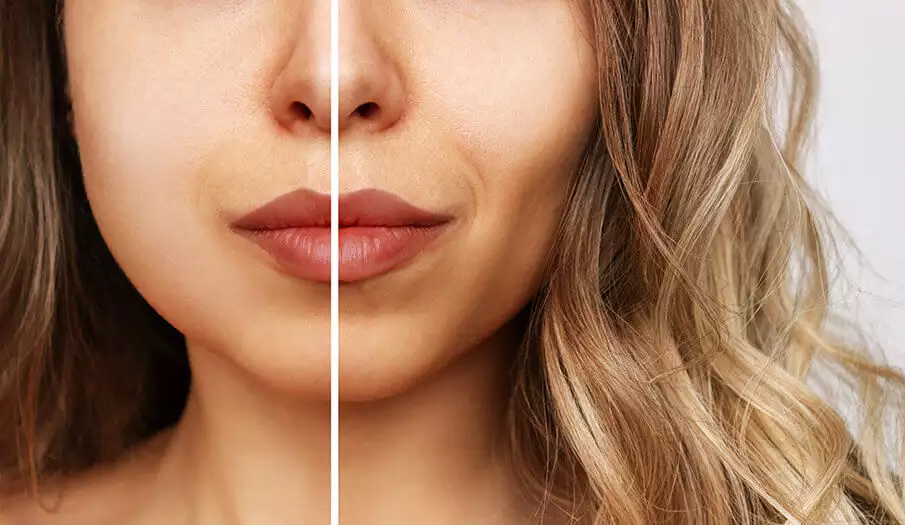
Buccal Fat Removal
What is Buccal Fat Removal Surgery?
Buccal Fat Removal, also called Bichectomy or Hollywood Cheek, is a Facial Aesthetic Surgery that aims to make the cheekbones appear more prominent and the facial lines sharper by removing the buccal adipose tissue in the cheek area. Buccal Fat Removal changes U-shaped facial lines into a sharper V shape. Buccal Fat Removal leaves no visible stitch marks and is permanent as long as there is no excessive weight gain.
Why is Buccal Fat Removal performed?
Buccal Fat Removal surgery is performed on patients who have excess fat accumulation on their cheeks in connection with their facial structure. The fat tissue hides facial features and gives a chubbier look to the patient’s cheeks, which can wrongly present an image of being overweight.
After the Buccal Fat Removal surgery, sharp lines appear on the face of the patient in the form of an aesthetically pleasing inverted triangle.
What are the conditions for Buccal Fat Removal?
Bichectomy, which can also be defined as cheek thinning surgery, can be applied to both men and women. Buccal Fat Removal is not recommended to patients who:
- Are younger than 25 as the facial features of younger patients can continue to change until 25.
- Have a Body Mass Index, BMI, above 25 as overweight or obese patients are often dissatisfied with their look after weight loss.
- Smokers, and individuals over the age of 45.
- Have thin cheeks. Buccal fat removal is better suited to patients with full cheeks, which can avoid adverse effects that might appear with advanced age.
- Are not suitable for general anesthesia. Patient's health history is reviewed and appropriate preoperative diagnostic testing is performed to assess eligibility.
What Are The Things To Be Considered Before Buccal Fat Removal?
Before the Surgery, patients should:
- Be at the hospital a day before their surgery for the pre operative tests to be performed.
- Stop smoking, drinking alcohol, and using recreational drugs a month before the surgery.
- Avoid medication containing aspirin or ibuprofen (Advil, Motrin IB, others) for two weeks before and after surgery. These medications may increase the risk of internal bleeding. Patients should confirm each medication and supplement they wish to take with their Patient Coordinator.
How is the Buccal Fat Removal performed?
Buccal Fat Removal can be performed under either general or local anesthesia. An incision is made towards the back of the oral cavity, near the second upper molar, in the mouth. Buccinator muscle then becomes visible, its fibers are separated, without an incision, until the Buccal Fat is accessible. Then, a thin casing over the fat is opened and the fat is gently teased out by an externally applied gentle pressure. The fat is then cauterized at the base and removed. The remainder of the buccal fat pad then is placed back to its anatomic site and the oral mucosa, as well as the incisions, are sutured. On average, the procedure takes about 30 minutes.
What are The Things To Be Considered After Buccal Fat Removal?
Patients are advised to:
- Not eat or drink anything until three hours after the surgery.
- Prevented the swelling in the mouth by applying cold presses for 15 minutes at regular intervals in the first 3 days after Buccal Fat Removal.
- Gargle with salt water every 12 hours for the first 7 days after the surgery since the surgery is performed inside the mouth.
- Avoid strenuous physical activities.
- Use prescribed medicine as instructed by the Plastic Surgeon.
- To put on sunscreen when going outside for the first few weeks after surgery, especially if the surgery was performed in the summer.
- Keep good dental hygiene to prevent an infection as the stitches are inside the mouth.
- Wait a week for the swelling to go down, and 2 to 4 months for cheeks to reach their permanent look.
What Are The Risks of Buccal Fat Removal?
While Buccal Fat Removal is a short and simple Aesthetic surgery, like any major surgery it has some risks associated with it. The possible risks of buccal fat removal surgery include, but are not limited to:
- Bleeding
- Deep vein thrombosis, cardiac and pulmonary complications
- Seroma
- Hematoma
- Infection
- Injury to a salivary duct
- Injury to branches of the facial nerve, resulting in temporary or permanent facial muscle weakness
- Numbness or other changes in sensation
- Prolonged swelling
- Suboptimal aesthetic result and/or minimal changes
- Risks associated with anesthesia
